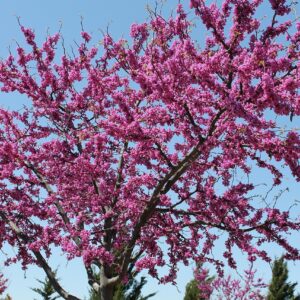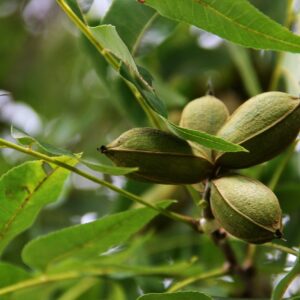Asimina triloba, commonly known as the Pawpaw, is a deciduous tree or shrub native to the eastern United States. It is notable for its unique fruit, distinctive foliage, and ecological value. Asimina triloba (Pawpaw) is a unique and attractive tree that offers both ornamental and practical benefits. Its exotic fruit and distinctive foliage make it a valuable addition to gardens and natural landscapes.
Appearance:
Size: Pawpaw typically grows 10-30 feet tall, with a spread of 10-15 feet. In ideal conditions, it can sometimes reach up to 35 feet (10.5 meters) in height. It has a relatively spreading, open canopy.
Leaves: The leaves are large, ovate to elliptical, and measure 6-12 inches (15-30 cm) long. They are dark green, with a smooth texture and a slightly wavy edge. In the fall, the foliage turns yellow, providing a bright display before dropping.
Flowers: Pawpaw flowers are unique and appear in late spring (April to May). They are large, with three purple to maroon petals and a central column of greenish-yellow stamens. The flowers have a distinctive, somewhat unpleasant smell, which attracts their primary pollinators, such as beetles and flies.
Fruit: The fruit of the Pawpaw is one of its most distinctive features. It is a large, fleshy berry that typically measures 3-6 inches (7.5-15 cm) long. The fruit is green when immature and turns yellow to brown as it ripens, with a custard-like texture and a flavor often described as a mix of banana, mango, and melon. Inside, the fruit contains several large, dark brown seeds.
Bark: The bark is typically smooth and grayish-brown on young trees, becoming more furrowed and rougher with age.
Habitat: Pawpaw thrives in a variety of habitats, including rich, well-drained bottomlands, upland forests, and along riverbanks. It prefers moist, loamy soil but can tolerate a range of soil types. It is hardy in temperate climates, typically found in USDA Hardiness Zones 5 to 8.
Uses:
Culinary: The fruit of the Pawpaw is edible and has a sweet, tropical flavor. It can be eaten fresh or used in a variety of culinary applications, including smoothies, ice creams, pies, and preserves.
Ornamental: Pawpaw is valued for its large, tropical-looking leaves and unique flowers. It can be used in landscaping as a specimen tree or as part of a naturalized garden.
Ecological: The Pawpaw provides habitat and food for wildlife. The fruit is consumed by various animals, including raccoons, deer, and squirrels. The tree also supports various pollinators.
Care:
Pruning: Pruning is typically done to maintain the shape of the tree and remove any dead or diseased branches. Pruning is best done in late winter or early spring before new growth begins.
Watering: Pawpaw prefers consistently moist soil but can tolerate periods of drought once established. Regular watering is beneficial, especially during dry spells.
Fertilizing: A balanced, slow-release fertilizer applied in early spring can support healthy growth and fruit production.
Pollination: Pawpaw flowers are pollinated by beetles and flies, so the presence of these insects is important for fruit set. Planting multiple trees can improve pollination and fruit yield.





